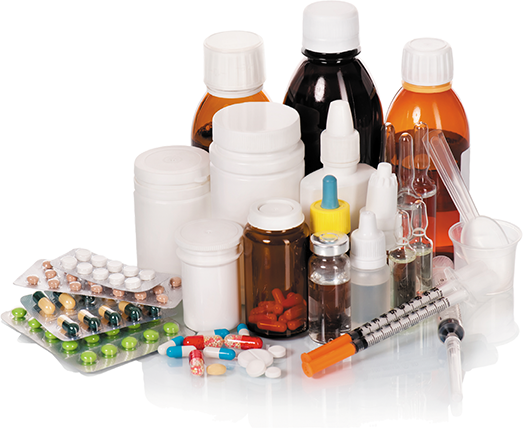5.1 Routes of Administration
Medications can be introduced into the body by several routes. A route of administration is a way to get a drug into or onto the body, and there are many ways to do this—through the mouth, by swallowing, as with tablets; through the skin with ointments or patches; through the inner linings of the mouth, rectal, or genital areas; through injections, as in shots or IV solutions; or through surgical implants. Drugs are aimed at two kinds of therapeutic effects—either a systemic effect, where the drug gets into the bloodstream to affect the whole body or a bodily system; or a localized effect, where the drug is meant to exert its therapeutic action at or near the site of administration (for example, an ear drop in the ear).
 Pharm Fact
Pharm Fact
A localized drug can sometimes have a systemic side effect, and a systemic drug can sometimes have a localized side effect.
A dosage form is the physical manifestation of a drug—such as a tablet, capsule, suspension, ointment, cream, patch, or injection—that is designed to deliver the medication by a specific route of administration. The dosage form selected is the one best suited to produce the desired systemic or localized effect in either an immediate or time-delayed manner. The suitability of the various common dosages for both systemic and localized routes of administration will be explained later in this chapter, along with their advantages and disadvantages. Table 5.1 outlines their categories.
As you can see, dosage forms are adapted to different routes of administration, depending on their intended uses. Furthermore, many drugs, such as nitroglycerin, can be delivered to the body via different routes of administration: orally as a tablet or capsule; transdermally (through mucus linings) as a patch; sublingually as a tablet (under the tongue); translingually (across the tongue) as a spray; topically as an ointment; via inhalation as an aerosol spray; or intravenously as an IV solution.
Effects, however, are not always so clear-cut. It is important to understand that some medications used for localized effects can also have unintended systemic effects. For example, inhaler solutions used to open airways in patients with asthma can also have some systemic absorption that results in tremors, dizziness, nervousness, and other side effects. Pharmacists need to keep unintended systemic effects in mind as well as any possible interactions with systemic drugs. A drug with a systemic route of administration can also produce a localized side effect at the area of the administration site, such as numbness at the injection site of a systemic painkiller.

Medications are available in many dosage forms that can be given by several routes of administration..
Table 5.1 Common Routes of Administration and Corresponding Dosage Forms
Route of Administration |
Common Dosage Forms |
|---|---|
Systemic Effects |
|
Oral enteral (into mouth and swallowed) |
Tablets, capsules, syrups, suspensions |
Transmucosal (through mucous of inner linings):
|
|
Topical transdermal (absorbed through the skin) |
Creams, ointments, pastes, patches, plasters |
Inhalation/intrarespiratory (breathed in) |
Dry powder inhalers, metered-dose inhalers, nebulizer solutions |
Parenteral/injection |
Injection shots, injectable pen solutions, IV solutions |
Rectal and vaginal (transdermal and transmucosal) |
Rings, suppositories, solutions (these are less frequently systemic) |
Implants |
Pumps, radiation seeds, stents, wound dressings |
Localized Effects |
|
Topical dermal (on or in the skin) |
Creams, lotions, ointments, powders, solutions |
Inhalation (breathed in) |
Dry powder inhalers, metered-dose inhalers, nebulizer solutions |
Transmucosal (through mucous membranes):
|
|
Vaginal and rectal (transdermal and transmucosal) |
Suppositories, solutions, creams, gels, ointments |